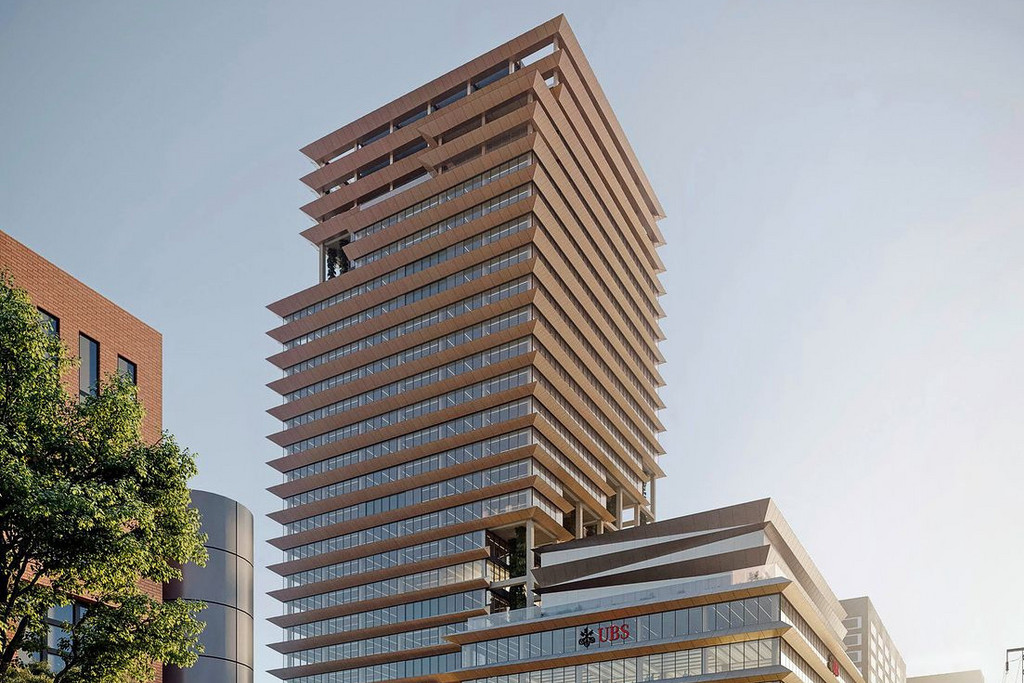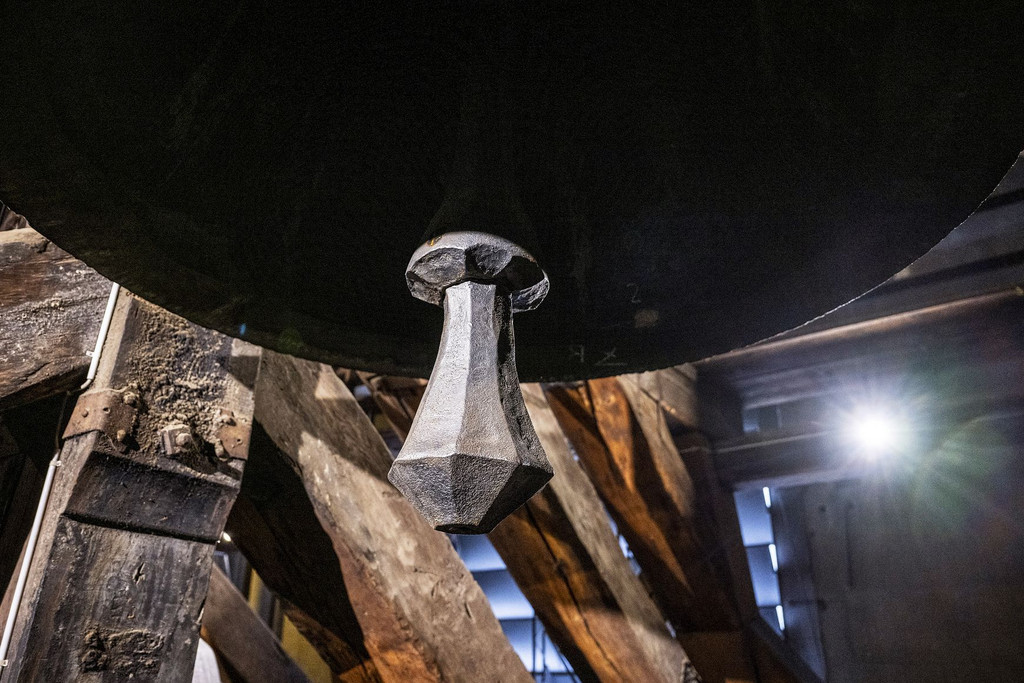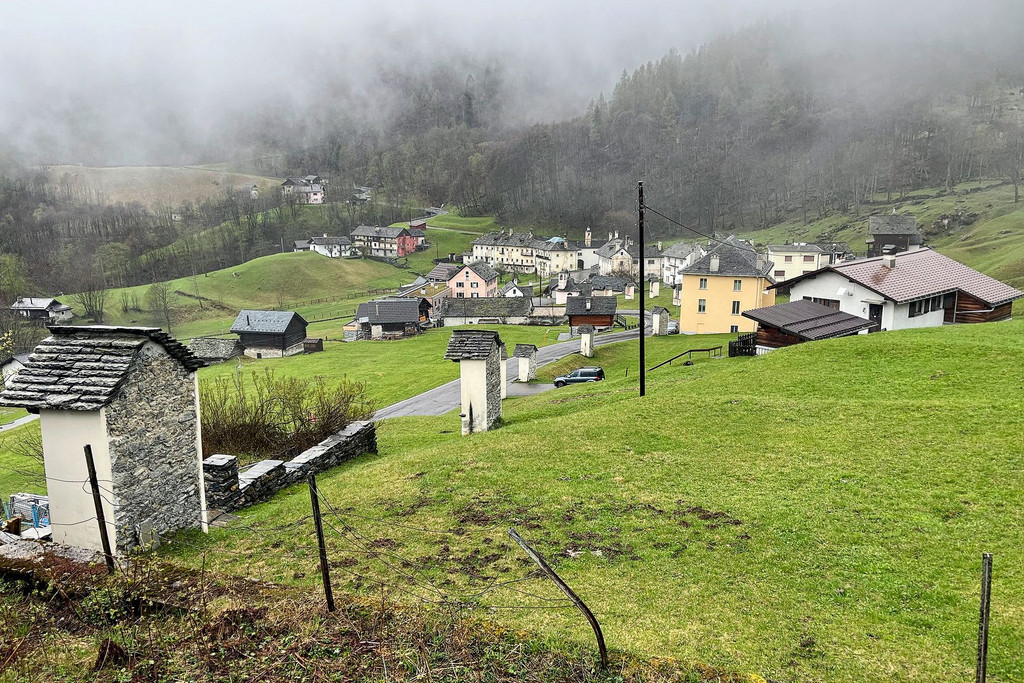The street leads steeply upwards, passing by the 220-metre-high Verzasca Dam, which became world famous when James Bond jumped off it in the movie “GoldenEye”. And then it runs alongside the dam until you finally catch sight of Corippo. The small village is perched on the right side of the valley like a bird’s nest; the stone houses and slate-covered roofs seem to merge into one with the terraced slopes and surroundings. The church tower is in the centre of the village. The first thing visitors see on entering the village is a small cemetery. However, the All Saints’ Day candles have burnt down, and the flowers have wilted.
It should be rather romantic, but with rain and a light snowfall, the little village appears sad and unwelcoming on this wintry afternoon. There is a sign reading “Chiuso – geschlossen seit 30 Oktober” (Closed since 30 October), in front of the only Osteria (restaurant) in the village, which is a popular stop-off for hikers in summer. According to the Federal Statistical Office, the municipality only has eleven inhabitants with an average age of 70 plus. This makes it the smallest municipality in Switzerland, although not for much longer: in April, Corippo will become a district of the joint municipality of Verzasca.
Nowadays, many houses in Corippo are empty or only used as holiday residences in summer. During its heyday in 1850, almost 300 people lived there. Since then, things have gone downhill. Corippo has suffered the same fate as all of Valle Verzasca and other Alpine regions in northern Ticino. Poverty combined with a lack of work and income led to an exodus. The roman à clef on Ticino history, “Il fondo del sacco” by Plinio Martini (in English: “No beginning, no end”) about emigrants from Valle Maggia, could easily have taken place in Valle Verzasca.
The superlative of being the smallest municipality in Switzerland still applies to Corippo for now. However, the locals do not seem to think a great deal of this. And they want to speak about it even less. Questions from outsiders on the state of the smallest municipality are answered grumpily or simply ignored. “Everyone has migrated down the valley,” murmurs a senior citizen, who quickly closes the garden door behind him.
Corippo has not had a working local government for many years. The 55-year-old Claudio Scettrini, a forestry worker and the youngest inhabitant in the tiny place, was the last president of the municipality. Together with his aunt and his sister-in-law, he made up the municipal council. “However, we always had to run everything past the canton, and in the end, nothing ever happened,” said Scettrini, when he resigned in frustration in 2017. Since then, the municipality has been managed externally.
In the eyes of Ticino state councillor Norman Gobbi, the inability of the smallest municipalities to guarantee a working administration is proof that there is no way past a targeted merger policy. A municipality the size of Corippo is no longer able to autonomously provide important services that are expected by its citizens nowadays. Water supply and canalisation cost millions. “Like many other municipalities, Corippo had to face up to this reality,” says Gobbi.
The merger of municipalities has been expedited for decades for this very reason. In 25 years, the number of municipalities in Ticino has fallen from 245 to 115. “Under the cantonal merger plan, we are seeking to reduce this number to 27 municipalities over the long term,” says Gobbi. The same process is happening across the country. Nationwide, the number of municipalities fell from 2,899 to 2,255 between the year 2000 and spring 2017. Some cantons such as Glarus have made a clean sweep: 25 local communities were reduced to three municipalities in 2011. There is a downside to this development, though. Sceptics are worried that people’s connection with their own municipalities of residence will be further weakened by the formation of these large associations.
Back to Corippo: in the old parsonage at the church, one of the locals speaks plainly: “People no longer want to speak with journalists as they have twisted our words.” It is a fact that, in the last few years, numerous media professionals have visited the village in the valley of Verzasca after it got out that a hotel village would be built there. Reports have even appeared in the New York Times. A television team from the BBC also roamed through the place.
But what is actually in the pipeline? Some of the old stone houses, known as Rustici, are to be converted into hotel rooms. The Osteria is to become a reception area where guests can also eat their meals. “Albergo diffuso” or “scattered hotel” is a concept that has already been implemented in several old settlements in Italy. Corippo would be a pioneer in Switzerland.
Fabio Giacomazzi is an architect, urbanist and president of the Corippo Foundation, which is driving the hotel project and bought a dozen old stone houses years ago for this purpose. The goal is to retain the “magical atmosphere” of the place but also to breathe new life into the hamlet at the same time. Giacomazzi has already shown numerous people around the village and abandoned buildings, in which time seems to have stood still. Sometimes there are even old shoes on the wooden floors or odds and ends in the corner. Cobwebs adorn the windows. However, a holiday apartment has already been set up in one of the foundation’s houses, and the mill has also been refurbished. The renovation of the other houses will finally start in early 2020. The mood in the village is somewhat sceptical. “They’ve been making promises for years,” says one of the locals.
Giacomazzi can understand their scepticism, but points out that the conversion work can only go ahead when all the money has been collected. The total budget is 3.6 million Swiss francs. “And at present, we still need just short of 600,000 Swiss francs,” says the architect. He seems confident that they will soon get the money together, ideally through private donations.
Claire Amstutz supports the project. She is the publican at the Osteria in Corippo. However, she rarely comes in winter. We run into her rather coincidentally while she is preparing a Sunday meal for her regulars: a Bernese plate – with dried beans, boiled potatoes, sauerkraut, bacon and sausage. Amstutz, who originally hails from the German-speaking part of Switzerland, is still unsure what the future holds; she is waiting for the new contract for the 2020 season.
It is interesting to note that there is already a certificate hanging in the Osteria bearing the words “Hotel Innovation Award”, which was conferred by the Swiss Society Hotel Credit and Gastrosuisse for the “Albergo diffuso” project in 2017. This prize has also brought many calls from people wanting to book a room. “Only it hasn’t been possible to date,” laughs Amstutz.
Thomas Egger describes the Corippo project as “exemplary”. The Valais CVP national councillor is president of the Swiss Working Group for the Alpine Areas (SAB). “A decentralised hotel is a wonderful starting point to improve the use of the existing structures,” he adds. And he refers to analogous initiatives in Grengiols (VS) under the name “Poort a Poort”, as well as in Albinen (VS) under the name “Albijou”.
Egger is strongly opposed to abandoning municipalities or parts of the Alpine area. And he also has the Federal Council on his side. The Swiss government approved a report in mid-November detailing how the existence of the Alpine areas is to be safeguarded and migration curbed. Expansion of digital infrastructure, i.e. with broadband and high broadband, is deemed essential.
Gerhard Lob is a Journalist in Locarno (TI)
















Comments
Comments :
Knapp 3000 Gemeinden auf 42000km² Schweiz verteilt; ein Unding eigentlich. Aber das durfte man damals nicht denken und schon gar nicht schreiben. Und deshalb wurden Gedanken zur "Melioration von Verwaltungseinheiten" auch gleich wieder aus meinen Entwürfen gestrichen. Die "Kritische Masse" von Verwaltungseinheiten war nur im Ausland ein Thema. Die parallele zum Frauenwahlrecht ist unübersehbar. Und beides liess sich zum Glück nicht verhindern.
Aber wir täten gut daran, diese Gebietsreform endlich zum zentralen Thema der Bundesraumordnung zu machen. Mit dem "Bundesgesetz über die Raumordnung", RPG, spielen wir in der Schweiz nämlich in der besten Liga der Welt; -wie mit der ETH.
Aktiv planen statt zuwarten!
Markus Reicher, Raumplaner
Ein Beispiel:
Deutschland / 80'000'000 Einwohner / 16 Bundesländer
Schweiz / 8'000'000 Einwohner / 26 Kantone
Maximal 6 bis 7 Kantone wären genug. Ergo est:
- Einsparung von 30-40% bei der zu teuren Verwaltung.
- mindestens 50% weniger unnütze Gesetze.
Das ist der Wunschtraum eines Ketzers und Querulanten.
Jedoch: "Der Kritiker/Querulant wird nicht als solcher geboren, sondern
ist das Produkt, der in seiner Umgebung obwaltenden Gegebenhei-
ten." (frei nach Lenin)
The heart of the Italian speaking community was the area around the Savoia (Spring Creek) Hotel and the Macaroni Factory. The Savoia is named after the royal family of the unified Italy. An Italian reading library was located at the hotel and pasta was made opposite in Lucini's Macaroni Factory which was also home to the Democratic Club. Lucini's moved from Lonsdale Street, Melbourne in 1865, where they had set up as the first pasta factory in Australia in 1864. Vanzetta's bakery supplied bread and Crippa, Perini and the Gervasonis (Yandoit Creek) produced wine.
A local delicacy is bullboar which is a sausage made from beef, pork, garlic and spices.[9] In 2005 Daylesford Secondary College came second in ABC's Young Gourmets by making bullboars from the Gervasoni and Sartori recipes which gained much media attention over the fate of Charlotte the pig, with little concern for the steer involved! [10] The Bullboar has been named an endangered recipe by the Slow Food Movement.
A book on the Swiss Italians in the region entitled Bullboar Macaroni and Mineral Water by Clare Gervasoni details the influence of the Swiss Italians on Hepburn Springs.
In 2007 the Melbourne Immigration Museum featured a display entitled Wine Water and Stone reflecting the Swiss and Italian heritage of the area.